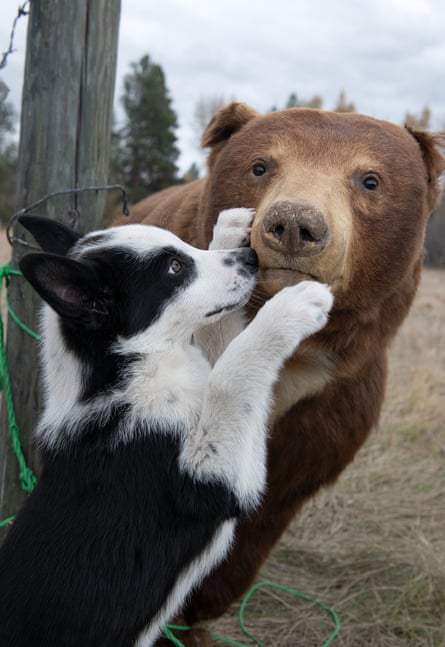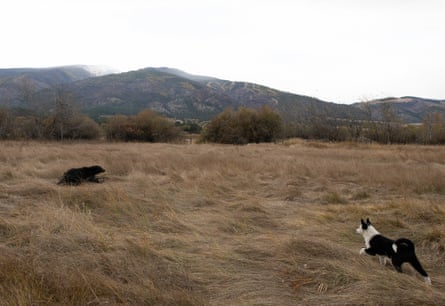The dog is moving through the grasses of the open meadow, closely followed by bear biologist Carrie Hunt, who is observing his reactions as he sees the grizzly bear carcass for the first time. “Find it,” says Hunt, encouraging the two-month-old puppy. The puppy’s ears and tail are up as he approaches the bear cautiously, but with the confidence that Hunt is looking for in a bear conflict dog.
This is a Karelian bear dog, a hardy breed from Finland known to be fearless and capable of standing up to large mammals such as brown bears and moose. People once used the dogs to hunt big game in regions that now are part of Russia and Finland. Today, in Montana, Hunt is using the dogs to keep bears alive.
Hunt founded the Wind River Bear Institute in 1996, where she trains Karelian bear dogs to scare away bears that get too close to human settlements and that would otherwise be killed. “I wanted to make things safer for bears and people,” she says.
Karelian puppies undergo a series of tests in which trainers teach them the right behaviours and evaluate their personality and how they react in situations that involve stuffed bears and cougars placed in the field. Just 20% of a litter will make the cut as bear conflict dogs, where a wrong move or slightest hesitation can lead to serious injury. “We are looking to figure out which ones have the right stuff. It is important for the safety of the people we are placing the dogs with,” says Nils Pedersen, director of the institute. “What we want to see is a dog that has an intrinsic motivation to hunt and find anything new and scary.”

When they are ready, the dogs are deployed across North America – for example, working with the Alaska fire service to keep firefighters safe on callouts and at the same time reduce the number of bears that are killed each year.
Between 2020 and 2022, dog handler Greg Colligan worked with one puppy on its first assignment helping to resolve conflicts between people and grizzly bears in Alaska’s Denali national park and preserve. “He was integrated into almost every facet of what we do as a wildlife management crew,” says Colligan, former lead wildlife technician for the park. “He helped us detect bears and push them out of an area if we needed to. He was key to everything we did.”
Karelian bear dogs are increasingly being used by wildlife and land managers not just in the US, but in Canada and even Japan to encourage social distancing between humans and wildlife.
In North America, bears live in landscapes where the human footprint is expanding. As a result, people and predators are forced to share space, setting the stage for increased human-wildlife conflicts. Bears may be tempted to visit human-dominated areas with easy to access food sources such as rubbish bins, chicken coops, bird feeders or fruit trees, especially in the summer and autumn, when they need to store energy for hibernation. With warmer temperatures resulting from the climate crisis and more human foods readily available, bears may even delay hibernation.
In Nevada, an increase in the black bear population is colliding with a growth in urban development. Game biologist Heather Reich reports that between 1987 and 1991, the Nevada Department of Wildlife received an average of 14 calls reporting conflicts with bears a year. Between 2007 and 2011, that number grew to more than 500, and in 2022, 1,450 calls were received. Reich attributes the latest surge to a late spring frost that killed the bears’ natural resources such as berries. “This drove bears down into urban areas searching desperately for food,” Reich says.
Clayton Lamb of the University of British Columbia studied demographic data for more than 2,500 brown bears in British Columbia over 40 years and found that in human-dominated landscapes, for every bear that lived to 14 years, 29 did not. By contrast, only four died during the same period in a wilderness area with no people to contend with. The animals that were able to survive in human-dominated areas had adopted a nocturnal lifestyle to avoid people. “If a bear can learn to live near people, they can survive, but very few bears make it to adulthood and figure out how to live in that landscape,” Lamb says.
In Nevada, wildlife managers first tried to scare human-habituated black bears away with noise makers and rubber bullets, but that did not always work. “The bears very quickly learned that was not that scary and that nothing bad happened,” Reich says.

In 2001, the wildlife department started employing Karelian bear dogs. Now, when a problem bear ventures too close, Reich and her colleagues catch the animal. Then, when the bear is released, the dogs chase it away in a brief pursuit. “For the bear, it is a really bad experience,” Reich says. Bears are naturally wary of canids as coyotes and wolves can kill their cubs. “The dogs have a body language, an animal-to-animal conversation that speaks much stronger to the bear than I can,” Reich says.
The lesson taught by the dogs is one that the bears seem to remember. A study of black bears in the Tahoe Basin led by Mario Klip, environmental scientist at the California Department of Fish and Wildlife, found that bears that had encounters with Karelian bear dogs became more nocturnal, were less active in winter, and spent less time in urban areas.
“The dogs make me a better biologist because they allow me to keep bears in the landscape as long as I possibly can, rather than having to kill and remove them,” Reich says.
With their keen sense of smell, bear dogs can also detect the presence of a bear early, allowing wildlife managers to take preventive measures while staying safe. “They allow me to do things with bears that I couldn’t do as a single human,” Reich says. “We have bears that den under homes. It feels a lot better crawling under these buildings with the dogs to help flush that bear out than me alone.”
Ultimately, while the dogs can help save a bear’s life, humans must also do their part by securing garbage in bear-resistant containers or installing electric fences.

At the Wind River Bear Institute, Hunt places an emphasis on “bear shepherding”. “It is about teaching bears and people the correct behaviours so they can live in the same area,” she says, but that will only work if people remove the lure of garbage and other temptations.
As Karelian bear dogs are generally people-friendly, they can help educate people about the need to adopt behaviours that will reduce conflict. “People want to talk to you when you show up with the dogs,” Colligan says. “The dogs are a way for us to connect with bears in a human-bear conflict situation, but they also allow us as humans to connect to each other.”
Source: The Guardian



























